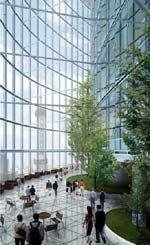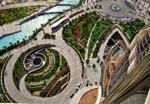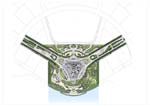
|

|
|
Home Site Search Contact Us Subscribe
|
|
Keeping Supertalls Grounded, Connected: Q&A with SWA's John Wong, FASLA, FAAR Tall buildings "are beautiful, sleek structures, truly awe-inspiring, but a lot of a building's long-term economic success is dependent on the integration and beauty at the ground level." By ArchNewsNow.com June 11, 2015 Connectivity and collaboration are not the first words one might think of in relation to the urban design for skyscrapers, but these themes permeate a recent conversation with John Wong, FASLA, FAAR, a managing principal and the chairman of SWA, and one of the most accomplished landscape architects working today. Chief among his most recognized works are the ground planes surrounding the world’s tallest buildings – as well as some of their sky-high interior greenspaces. Wong’s resume includes nearly a dozen supertalls, and as more are completed over the next few years, he will have designed the landscape architecture for five of the six tallest buildings in the world. These include: The 828-meter-high Burj Khalifa, Dubai, by Skidmore, Owings & Merrill (SOM); the 632-meter Shanghai Tower by Gensler, now complete; the 636-meter Wuhan Greenland Center by Adrian Smith + Gordon Gill, opening in 2017; a new world’s tallest, the 1,001-meter Kingdom Tower now under construction toward a 2018 opening in Jeddah, Saudi Arabia, also by Adrian Smith + Gordon Gill; and the 729-meter Suzhou Zhongnan Center, planned for 2020, will be one of the two supertall towers fronting the main plaza of the overall Suzhou Center designed by SWA. (Source: Council on Tall Buildings & Urban Habitat).
Q: What makes for a successful urban design around tall buildings?
John Wong: As tall as these buildings may be, a really successful project is still centered on people. You want to create an attractive environment that draws people and becomes a thriving neighborhood just like the rest of the city. With that, you have the economic activity supporting the building, and then other buildings and projects spring up nearby – it adds more life and more value to the immediate surroundings and the city’s whole economy.
Q: What is important for the landscape architecture of most any tall building, not just supertalls?
JW: As cities become more dense and the land is limited and expensive, it’s a major challenge for cities, developers, and designers to make sure there’s a thriving public realm with a strong connection to nature. In San Francisco, where I live, it’s being accomplished by providing a density bonus for developers, and the new Salesforce Tower by Pelli Clarke Pelli Architects [formerly known as the Transbay Tower] is creating a beautiful series of public spaces and parks to that end. Some cities put together several sites or reimagine underutilized spaces along rivers or other infrastructure so that the public realm is a natural feature of the overall design. It takes popular and political will, but these urban interventions on a grander scale are what make cities more livable. They create a real connection between a high-rise and its city, too. A strong public realm component is essential in making a major project truly successful.
Q: What are the challenges of landscape design for supertalls like Shanghai Tower?
JW: The ground plane is a key area of the design because these buildings are, in essence, a vertical city with a highly complex set of human activities and physical infrastructure converging at the ground, and then connecting with the city. The design has to accommodate the internal systems such as water and sewer but, more importantly, the transit systems, auto traffic, biking, even dog walking and getting your kids to school. It’s a 24/7 environment with people living there, shopping, working, and also relaxing. Like cities, tall buildings need to provide gathering areas and green spaces, too. That is a distinctive element of Shanghai Tower, where we’ve put an entire park on the ground and on every 22nd floor so you’re never very far from a public space where you can relax, meet your friends, or have lunch. The building was designed six years ago, and it was really advanced at the time, and still is, to use a second exterior skin at this scale to accommodate interior greenspaces and lower the energy use by regulating all of the interior climate.
These projects are beautiful, sleek structures, truly awe-inspiring if you get to see them, but a lot of a building’s long-term economic success is dependent on the integration and beauty at the ground level.
Q: What was unusual about the ground plane at Burj Khalifa?
JW: The Burj was the most ambitious undertaking of its time, and quite an accomplishment for Dubai and the region. With such an imposing structure commanding a wide area of influence, it was very important to tie into the fabric of the community, to add value and emotional connection. Some supertalls have to fit within a tight urban space, but at Burj Khalifa we were able to create an entire district, including a 27-acre Tower Park with a lake and green space that’s become a popular destination for everyone, not just for the tower visitors and occupants. I’m told that in the evening, certain areas are just teeming with people because it’s such a beautiful and exciting place to be. There’s an economic value story in the district’s design, too. The area around the Burj and the dramatic approach you have with Emaar Boulevard were planned to accommodate high-value development sites where other commercial buildings are built and are still going up. People love being in a supertall with its views and amenities, but another wave of development is beginning to fill in around it, capturing the views looking back at the tower and its setting.
Q: Are there other elements of supertalls that people sometime overlook?
JW: With a number of supertalls, the desire to create a connection to the city translates to a huge public atrium space that dominates the building entry. At Shanghai Tower, there’s a truly impressive atrium and entry that will add a great deal, I think, to Shanghai’s public realm. One challenge of the site in such a built-out district, however, especially being close to the river, is the limited space around it. By creating a dramatic public space within the tower, you have a place for social interaction and connectivity that’s for everyone, not just the building. Government buildings and monuments are often defined by dramatic atriums, and many private buildings have wonderful public spaces, such as the Ford Foundation building and Rockefeller Center in New York, which go back decades. It’s a wonderful amenity I think people will really enjoy at Shanghai Tower.
John Wong, FASLA, FAAR, is managing principal and chairman of SWA, an international landscape architecture, planning and urban design firm with offices in California, Texas, China, and the Middle East. John can be reached at (415) 332-5100 or jwong(at)swagroup.com
|
(click on pictures to enlarge)  SWA Shanghai Tower: overall landscape plan  Gensler Shanghai Tower atrium  Tom Fox, SWA (May 2015) Shanghai Tower  David Gal, SWA Burj Khalifa  David Gal, SWA Burj Khalifa  SWA Kingdom Tower plan  SWA Suzhou Center illustrative plan |
© 2015 ArchNewsNow.com